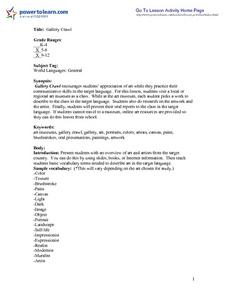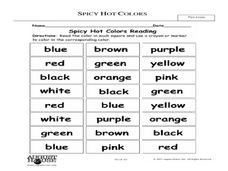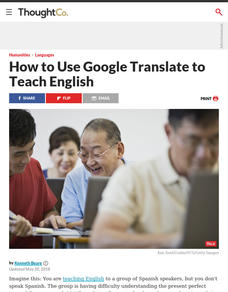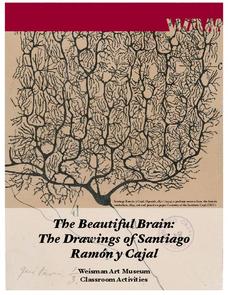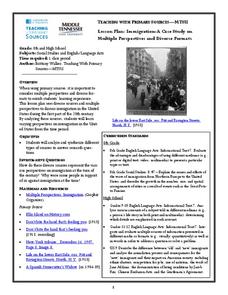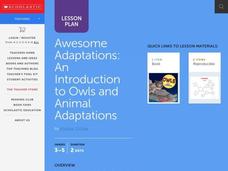Curated OER
Personal Opinions, Part 1
High schoolers interview their peers and teachers, in Spanish, about environmental issues. They write a response to their interviews and create a Venn diagram to identify similarities and differences between two cultural responses.
Curated OER
San Luis Trip
Second graders get an authentic field trip view of an archeological site replicating the influences of the Apalachee Indians and Spanish missionaries. The following day, 2nd graders share their journals at team tables.
Curated OER
The Three Bears
Second graders are comparing and contrasting two stories, The Three Bears and Abuelo and the Three Bears. The first story is the traditional fairy tale. The second one is a different version of the story with some Spanish words and phrases.
Curated OER
Personal Opinions, Part 2
Students create questions for an interview about the environment. They interview a peer using their written questions, and then interview a native Spanish speaker about the environment.
Curated OER
Mrs. Portillo
Students view a film about the importance of working together. They idenitfy different people's roles in the community. They participate in activities in which they practice Spanish vocabulary.
Curated OER
Try Your Hand at Han'geul
High schoolers explore Han'geul, a Korean writing system. Pupils participate in a class discussion involving the history of Han'geul. Using specified websites, classmates create flashcards containing letters of the Han'guel language. ...
Curated OER
Gallery Crawl
Students explore art and artists from a specific country. While on a field trip to an area art museum, students choose one painting to sketch. After researching the chosen painting, students prepare a presentation in the targeted...
Curated OER
Scavenger Hunt: Abuela
In this reading worksheet about the book Abuela, students find vocabulary words, list plural nouns and write Spanish words found in the story.
Curated OER
Cinco De Mayo Vocabulary "Quiz"
In this Cinco De Mayo vocabulary activity, students match vocabulary words on the left with definitions on the right. Worksheet includes a link to additional activities.
Curated OER
Spicy, Hot Colors
Students demonstrate an understanding of colors. In this visual arts lesson, students read the text Hot, Spicy Colors and name their favorite colors. Students complete a bar graph to show the data. Students discuss how each color can...
Curated OER
History in the Making: The Tortilla
Fourth graders examine the history of the tortilla and extend the study across the curriculum. In this history of the tortilla lesson, 4th graders research the background of the tortilla, determine the ingredients, and work with the...
Curated OER
Mexico: One Land, Many Cultures
Students, through a variety of activities, discover the geography and culture of Mexico. They make maps, read folktales, write a journal, create pinatas and other artistic pieces, and review the history of Mexico.
Curated OER
Las Misiones de California
Fourth graders work in partners to complete a series of activities. After reading the introduction, Students select a role of either a "Padre" or "Indigena." As partners, they need time on the computer for research as well as time to...
Curated OER
Translation Lesson to help Students Improve Vocabulary and Writing Style
Students translate an entire Internet page from English into a target language. In small groups, they create a short story or document in their native tongue or find an Internet page in their own tongue that they translate into English.
Curated OER
Texas Treasures
Students explore the meanings of the word "treasure," and examine the use of clay in the construction of buildings in San Antonio, Texas. They examine clay artifacts, and watch a video about pottery artist, Harding Black. Students then...
Curated OER
El Tiempo en Chile
Learners analyze what information would one expect to find in a weather report. They list in Spanish weather conditions for today in their community. Students visit Chile and locate it on a map.
Curated OER
Animal's Locations
Students identify pictures of animals that are posted throughout the classroom. Using locations, they match the correct animal with its home. They discover some of the animals could live in many different places. They answer questions...
Curated OER
Where In The World?
Students identify the goods and services from the United States and Mexico. Using postage stamps, they describe the various images they see and place them into categories. They use those categories to determine what is important in...
Curated OER
Como lo veo
Students pretend there is breaking news in their local area. After reading other eye-witness accounts, they identify the components of an article of this type. They write their own eye-witness account, share them with the class and...
Curated OER
Recuerdos De Mis Vacaciones Mexicanas.
Young scholars are presented with five items found in a suitcase to reflect upon the experience of a Mexican vacation. They use realia to produce a journal entry about one of the objects and its uses. The item is then brought to the...
University of Minnesota
Beautiful Brain: Strangest Dream
Do words change or add meaning or interest to a work of art? The final lesson in a four-part series on the beautiful brain as a work of art focuses on art analysis. Scholars write a story about exploring art from the inside. Reflections...
NASA
Let's Investigate Mars
Take your science class on a hypothetical field trip to Mars with an engaging astronomy instructional activity. After first learning about NASA's Mars rover missions, young scientists plan their own scientific investigations of Earth's...
Middle Tennessee State University
Lesson Plan: Immigration: A Case Study on Multiple Perspectives and Diverse Formats
As part of a case study of U.S. immigration during the first part of the 20th century, class members examine a variety of primary sources that present multiple perspectives of the responses of those in favor of immigration and those...
Scholastic
Awesome Adaptations
Engaged learners discover how an owl beak works and how animals adapt to their environment. This task is part one of a three-part series.








